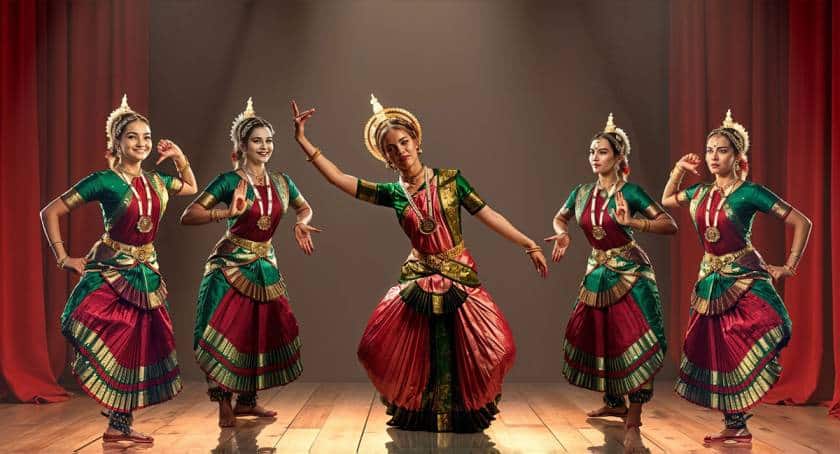Odissi Meets Contemporary: A Unique Dance Fusion
Dance has always been a profound medium of expression, transcending time, culture, and tradition. It serves as a bridge between the past and the present, carrying forward historical narratives while embracing new forms of artistic exploration. One of the most fascinating aspects of dance is its ability to evolve while preserving its roots. Fusion dance combines traditional and modern elements and has gained immense popularity. One remarkable fusion is blending Odissi, one of the oldest classical Indian dance forms, with contemporary dance styles. This combination creates a mesmerizing experience, offering a fresh perspective on tradition while embracing modernity.
Understanding Odissi Dance
More than 2,000 years ago, dancers in the temples of Odisha, India, created the classical dance style known as Odissi. It was initially performed as a form of devotion and storytelling, depicting mythological tales from Hindu scriptures like the Ramayana and Mahabharata. Over time, Odissi evolved into a highly stylized and refined dance form characterized by grace, fluidity, and intricate footwork.
Some key characteristics of Odissi include:
- Tribhangi Posture: A unique stance that divides the body into three parts—head, torso, and hips—creating a sculptural effect that adds to the dance’s aesthetic appeal.
- Mudras (Hand Gestures): Dancers use these symbolic hand gestures to communicate emotions and narratives, adding depth to the storytelling aspect of the dance.
- Fluid and Rhythmic Movements: A seamless blend of graceful upper-body movements and precise footwork, creating a hypnotic visual rhythm.
- Expressions (Abhinaya): Highly expressive facial movements that convey various emotions, bringing the stories to life.
Odissi is deeply rooted in tradition and structure, making it a perfect foundation for fusion with contemporary dance.
Core of Contemporary Dance
Contemporary dance is a modern art form that emerged in the 20th century as a reaction against the rigid structures of classical ballet. Its fluidity, versatility, and emotional depth characterize it. Unlike traditional dance forms, contemporary dance is not bound by strict postures or rules, allowing dancers to experiment freely with movement and expression.
Some defining features of contemporary dance include:
- Freedom of Movement: Contemporary dance does not adhere to fixed postures, allowing for a more natural and expressive flow of motion.
- Expression and Emotion: The form emphasizes the conveyance of emotions through movement, making performances profoundly personal and relatable.
- Innovative Choreography: Contemporary dance, which mostly depends on imagination and experimentation, encourages dancers to try out novel moves.
- Use of Space: Dancers use a range of levels, orientations, and dimensions to create dynamic and captivating performances.
Contemporary dance’s flexibility makes it an ideal counterpart to Odissi’s structured elegance, leading to a unique and innovative fusion.
Spellbinding Fusion of Odissi and Contemporary Dance
The fusion of Odissi with contemporary dance creates an innovative and captivating performance. It maintains Odissi’s traditional beauty while incorporating contemporary dance’s fluidity and dynamism. This blend allows dancers to explore new dimensions of movement and storytelling.
- Harmonizing Movements
Odissi’s intricate footwork and sculpted postures blend seamlessly with contemporary dance’s flowing and expressive movements in fusion dance. Odissi’s rigid and structured elements are softened by the fluid transitions of modern style, making the performance more dynamic and visually appealing. The result is a captivating dance form that retains classical Odissi’s discipline while embracing the expressiveness of contemporary movement.
- Storytelling in a Modern Context
Odissi traditionally narrates mythological stories with themes rooted in devotion and spirituality. However, fusion dance enables artists to explore a broader range of narratives, including contemporary themes such as social issues, human emotions, and abstract concepts. Performers can establish fresh and captivating connections with contemporary audiences by fusing Odissi’s narrative methods with the free-form expressiveness of modern dance.
- Music and Rhythm
In both Odissi and modern dance, music is essential. While Odissi dancers often perform to classical Indian music featuring traditional instruments like the mardala (a type of drum), contemporary dancers incorporate modern compositions, electronic beats, and fusion music. Dancers can produce a complex and engrossing aural experience that amplifies the performance’s visual attractiveness by coordinating classical rhythms with modern beats.
- Costume and Aesthetics
Traditional Odissi attire consists of elaborate silk sarees, silver jewelry, and intricately tied hair adorned with flowers. In fusion performances, dancers often modify their costumes to blend traditional and modern aesthetics. Combining conventional fabrics with contemporary cuts, minimalistic accessories, and innovative styling creates a visually striking appearance that complements the fusion of dance styles.
The Future of Odissi-Contemporary Fusion
Fusion dance is gaining recognition worldwide, with many dancers experimenting with new styles. A popular artistic medium that bridges the divide between tradition and modernity is odissi-contemporary fusion. With increasing interest in cross-cultural collaborations, this fusion form has the potential to reach global audiences and inspire future generations of dancers.
Several renowned dancers and choreographers are pushing the boundaries of fusion dance, blending Odissi with modern dance, jazz, and even hip-hop elements. Dance festivals, workshops, and social media platforms allow artists to showcase their creativity, further popularizing this unique fusion.
Additionally, Odissi-contemporary fusion can preserve classical dance while making it more accessible to younger generations. Classical dance forms can remain relevant in a rapidly changing artistic landscape by incorporating modern elements. This fusion serves as a testament to the adaptability and resilience of traditional dance forms, ensuring that they continue to evolve without losing their essence.
Final Thoughts
Combining Odissi with modern dance honors traditional Indian dance while celebrating innovation and heritage. As more artists adopt this combination, dance develops while remaining loyal to its origins, opening up new possibilities. As a dancer or spectator, Odissi-contemporary fusion provides an enthralling experience of storytelling, emotion, and movement. Tradition and modernity may coexist and enhance the performing arts, as seen by this mix. It pushes the limits of traditional dance and shows that creativity flourishes when tradition and innovation come together, motivating upcoming generations.


